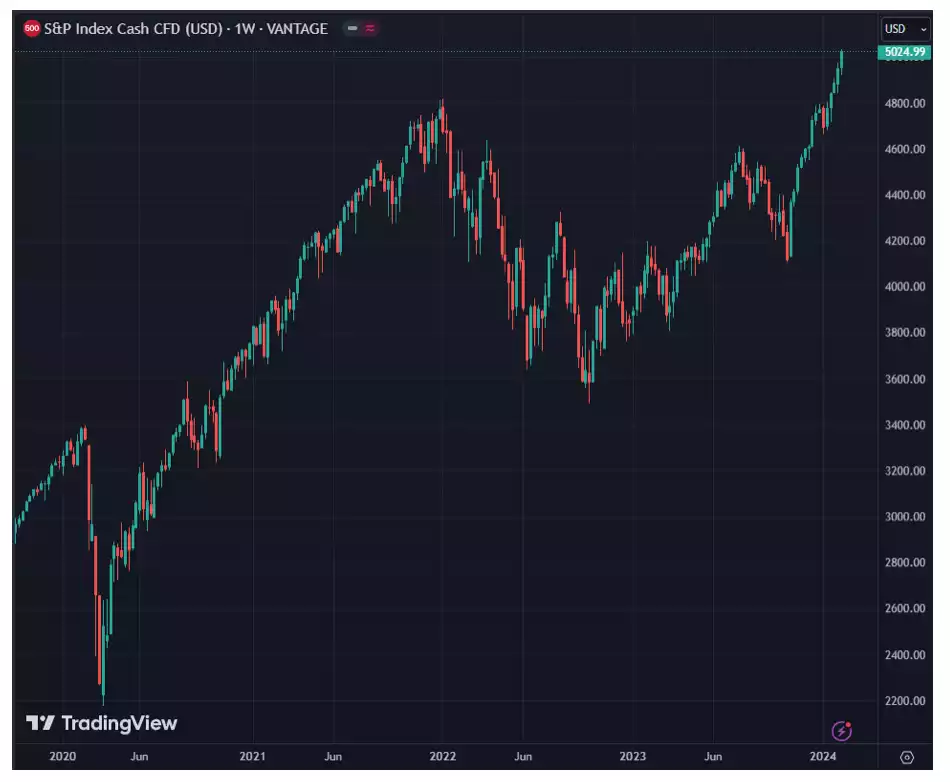Investors are Making Chaotic Trades
News
|
Posted 12/02/2024
|
2069
Investors are frantically rotating investments in dangerous sizes chasing an “up forever” dream. The percentage changes are unheard of.
Beneath the seemingly tranquil surface of the stock market lies a potential storm ready to disrupt the calm. On the exterior, the S&P 500 index showcases a 1.1% weekly rise, closing above 5000 for the first time and end higher for the 14th time in the last 15 weeks, a feat not seen since 1972. The Dow Jones Industrial Average remains relatively stable, and the Nasdaq Composite has surged by 1.9%.

On the surface, the prevailing narrative suggests a serene scenario: Inflation moderating, the Federal Reserve contemplating interest rate reductions, and sustained economic growth. This backdrop seemingly bodes well for corporate profits, supported by recent earnings releases exceeding expectations by 6.8%, surpassing the 5.7% average of the preceding four quarters, and hinting at a 9% earnings growth in the fourth quarter.
However, this apparent calm is merely a facade. Nowhere is this more evident than in the stocks of companies disclosing their fourth-quarter results. Although earnings are typically associated with significant stock movements, recent reactions have been unusually pronounced. As of Thursday, data from Dow Jones indicates that the median S&P 500 stock has experienced a 3.6% post-reporting move, nearly a point higher than the 2.7% median over the past decade.
These heightened fluctuations stem from the prevailing uncertainty surrounding individual companies, a stark contrast to the seemingly assured outlook for the broader market. Investor apprehension is palpable, fuelled by concerns about an expensive market—trading at 20.4 times 12-month forward earnings—ascending without carefully considering potential headwinds such as economic slowdown, inflation falling short of the Fed's target, or stagnant interest rates.
When investors feel on edge, they react more dramatically and emotionally. This may very well be the reason for investors rotating in and out of stocks in large sizes. The rush towards stocks seen as strong also leaves underperformers feeling rug pulled.
Companies falling short of market expectations in their earnings releases have been hit hard. FMC, for instance, witnessed an 11.5% drop following below-consensus guidance attributed partly to adverse weather conditions in Brazil. Conversely, companies delivering positive news experience surges in their stock prices, as demonstrated by Palantir Technologies, which soared 31% after reporting earnings that exceeded expectations, buoyed by robust demand from commercial clients. Let those percentages sink in. Investors are creating years’ worth of movement in days recently by making emotional trades.
Remarkably, this heightened market volatility has not yet translated into an equivalent increase in the CBOE Volatility Index (VIX), currently resting near 12.8—well below its 20-year average of 17.7. This discrepancy raises concerns, especially considering the S&P 500's substantial 21% gain since hitting a low in October. The risks looming on the horizon, including elevated valuations, persistent inflation, a cautious Federal Reserve, and the possibility of a recession mean that we could be seeing a downturn in major indices. In this case, we could see the safe havens gold and silver rise as the emotional traders rotate into their next lifeboat.